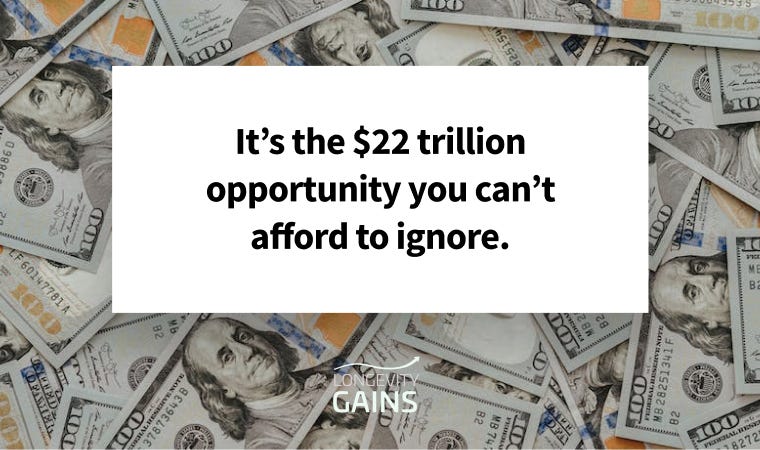Forget Everything You Know About “Old” People and Stake Your Claim in the $22 Trillion Longevity Economy
Are you ready to serve the most powerful economic group on the planet?
No, it’s not the Millennials or Gen Z. Our marketing obsession with youth may go down kicking and screaming, but cold hard logic (not to mention cash) says things are about to shift in a big way to the other end of the spectrum.
We’re talking about the group of people currently over the age of 50. This is already the cohort with the most spending power, and that will only increase over the years to come.
In other words, the “longevity economy” is the largest and fastest-growing market in the world. It’s the $22 trillion opportunity you can’t afford to ignore.
Smart marketers and entrepreneurs are developing longevity marketing strategies, and many are making it their central strategy. For a variety of reasons you’ll soon understand, this market is wide open — but it won’t stay that way for long.
Longevity Gains is an email newsletter and podcast from content marketing pioneer and serial digital entrepreneur Brian Clark. Each week he reveals additional aspects of this multi-trillion dollar emerging market and how to capitalize on it.
A Massive Demographic Shift
You can’t escape hearing about the shift. Lower birthrates and longer lives mean older people are becoming a force that can’t be ignored any longer.
And why would you want to ignore this level of economic clout?
People age fifty and over already account for more than half of consumer spending in the United States and 83 percent of household wealth, with both numbers expected to increase significantly.1
Within a decade, the largest economic group will be the population above age sixty, which will give rise to the “gray market”—the largest consumer bloc of all.2
By 2050, one in six people worldwide will be over 65, one in four in Europe and North America.3
And Yet, It’s Not About Demographics
One reason the 50+ market is such a wide-open opportunity is it’s been virtually ignored. We’ll explore why, and what’s changing beyond the sheer numbers.
Another reason is that the marketing efforts that have been aimed at those over age 50 range from ineffective to downright insulting.
That has a lot of causes, from misconceptions about older consumers to good ol’ ageism. And then there’s the foolish idea that everyone over a certain age is just one big bucket of folks to spew poorly-crafted messages and generic caricatures at.
Older adults go though various stages after 50, 60, and beyond. When you understand what this means from a messaging and product standpoint, you’re ready to craft a winning longevity marketing strategy.
Join us!
Golden, Susan Wilner. Stage (Not Age) (p. 26). Harvard Business Review Press.
Guillén, Mauro F. 2030: How Today's Biggest Trends Will Collide and Reshape the Future of Everything (p. 6). St. Martin's Publishing Group.
Schurman, Bradley. The Super Age (p. 4). HarperCollins.




